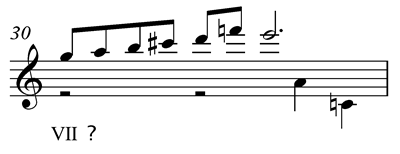Forms : Early Variations
One of the earliest examples of theme with variations belongs to Luys de Narváez, a Spanish vihuelist of the XVI century. He did not call them variations, he called them diferencias (differences) and are based on a song titled Guárdame las vacas.
The song's harmonic plan is used by Narváez to write four variations. He starts directly with the first variation.
According to Narváez, the work is written in the first mode (Dorian mode), but we will use the D minor key in our analysis. The 8 bars harmonic plan is repeated in each variation:
| Measure | 1 | 2 | 3 | 4 | 5 | 6 | 7 | 8 |
| D minor: | III | VII | i | V | III | VII | i - V | i |
The first variation or diferencia:

Follows the complete work. A small coda (measure 33) follows the fourth variation:
In measure 30 (fourth variation), Narváez makes a small variation to the harmonic plan. The original VII degree is not clear at all, and we find a minor V degree at the end:

Are these variations sectionals or continuous? The fact that the composer separates and identifies each variation makes them sectional. But since they are based on a short harmonic pattern, they may look like continuous variations.
